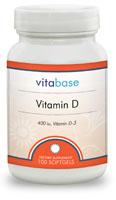| Vitamin D is a fat soluble vitamin that contributes to the maintenance of normal levels of calcium and phosphorus in the bloodstream. Vitamin D is different from all of the other vitamins in human nutrition because it is the only vitamin that is a conditional one. In adults, vitamin D deficiency may result in a softening of the bones known as osteomalacia. In children, vitamin D deficiency is called rickets and causes a bowing of bones not seen in adults with vitamin D deficiency. Vitamin D deficiency is
characterized by inadequate mineralization or demineralization of the skeleton. Inadequate mineralization of the skeleton is the cause of rickets in children (vitamin D is also known as the antirachitic factor), while demineralization of the skeleton results in osteomalcia in adults. Further, vitamin D deficiency in adults can lead to osteoporosis. This results from a compensatory increase in the production of parathyroid hormone resulting in resorption of bone.
People who get little exposure to sunlight are most at risk of vitamin D deficiency. Vitamin D deficiency can be caused by conditions that result in little exposure to sunlight. These conditions include: living in northern countries; having dark skin; being elderly or an infant, and having little chance to go outside; and covering one's face and body, such as for religious reasons. Many Arab women cover the entire body with black cloth, and wear a veil and black gloves when they go outside. These women may acquire vitamin D deficiency, even though they live in a sunny climate.
Sunshine is often a deciding factor in whether vitamin D deficiency occurs. Vitamin D deficiency in the winter is more common than previously thought and is even found in men who receive plenty of sun exposure in the summer. Those with chronic liver disease, cystic fibrosis, Crohn's disease, Whipple's disease and sprue are prone to vitamin D deficiency. Others at risk for vitamin D deficiency, include those that do not drink milk and who do not receive much sunlight, those who live in regions where they receive little natural light and alcoholics. The elderly are at risk for vitamin D deficiency for several reasons, including inadequate exposure to sunlight, consumption of low amounts of vitamin D-containing foods and the use of certain drugs which interfere with the absorption and/or metabolism of vitamin D. The use of sunscreens may be another factor that may negatively affect vitamin D status.
Vitamin D is most often associated with calcium metabolism and bone formation. Rickets, a disease characterized by softening of the long bones, results from vitamin D deficiency in children. In older people, bone fractures result from inadequate Vitamin D. Recently there have been reports that Vitamin D may be involved in immune response, muscle function and may be useful in the prevention of certain cancers. Older people (greater than age 50) are thought to have a higher risk of developing vitamin D deficiency. The ability of skin to convert vitamin D to its active form decreases as we age. The kidneys, which help convert vitamin D to its active form, sometimes do not work as well when people age. Therefore, some older people may need vitamin D from a supplement.
Newborn infants who are exclusively breastfed may require vitamin D supplements. Breastmilk does not contain significant levels of the vitamin, and although infants could receive this vitamin from sunlight, it is usually not recommended that small infants be exposed to sunlight in the levels required to produce a sufficient amount of vitamin D. Infant formula is generally fortified with vitamin D, so this requirement only applies to breastfed infants. The symptoms of rickets include bowed legs and bowed arms. The bowed appearance is due to the softening of bones, and their bending if the bones are weight-bearing. Bone growth occurs through the creation of new cartilage, a soft substance at the ends of bones.
| 